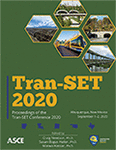Tran-SET 2020
A Comparative Study between Emulsion Residue Recovery Methods Based on Polymer Degradation
Publication: Tran-SET 2020
ABSTRACT
In this study, two commonly used emulsion recovery methods (beaker method and thin-film 2-day method) have been compared based on polymer degradation. The performance of polymer modified asphalt emulsion has been determined based on the ductilometer-based force ductility and recently introduced dynamic shear rheometer (DSR)-based extensional deformation test parameters. In the case of the force ductility test, the second peak force, F2, indicates polymer characteristics. In the case of the extensional deformation test, the second peak force, F2, detects the presence and quantifies the amount of elastomeric polymer in asphalt binder and emulsion. It was hypothesized that the lower the F2 value, the higher the polymer degradation. Three polymer-modified asphalt emulsions (CRS-2P, CHFRS-2P, and PME) were tested. The thin-film 2-day residue recovery method exhibited lower F2 value than the beaker method which, indicated the polymer network was damaged more during the thin-film 2-day residue recovery method. The findings of this study will help to understand the recovery methods of asphalt emulsion residue and select the appropriate recovery method.
Get full access to this article
View all available purchase options and get full access to this chapter.
ACKNOWLEDGMENTS
This study is funded by the Transportation Consortium of South-Central States (Tran-SET) under the project "Development of a Standard Test Method for Characterization of Asphalt Modifiers and Aging-Related Degradation Using an Extensional Rheometer".
REFERENCES
AASHTO T300-11. (2016), Standard Method of Test for Force Ductility Test of Bituminous Materials. AASHTO, Washington DC, VA.
AASHTO T315-11. (2012), Standard Method of Test for Determining the Rheological Properties of Asphalt Binder Using a Dynamic Shear Rheometer (DSR). AASHTO, Washington DC, VA.
AASHTO PP 72-11. (2013) Standard Practice for Recovering Residue from Emulsified Asphalt Using Low-Temperature Evaporative Techniques. AASHTO, Washington DC, VA.
ASTM D6934-08. (2016) Standard Test Method for Residue by Evaporation of Emulsified Asphalt. ASTM International, West Conshohocken, PA.
ASTM D6997-12. (2012) Standard Test Method for Distillation of Emulsified Asphalt. ASTM International, West Conshohocken, PA.
ASTM D7403-07. (2015) Standard Test Method for Determination of Residue of Emulsified Asphalt by Low-temperature Vacuum Distillation. ASTM International, West Conshohocken, PA.
ASTM D7404-07. (2016) Standard Test Method for Determination of Emulsified Asphalt Residue by Moisture Analyzer. ASTM International, West Conshohocken, PA.
ASTM D7497-09. (2016) Standard Practice for Recovering Residue from Emulsified Asphalt Using Low Temperature Evaporative Technique. ASTM International, West Conshohocken, PA.
Farrar, M. J., Salmans, S. L., and Planche, J.-P. (2013). Recovery and Laboratory Testing of Asphalt Emulsion Residue: Application of Simple Aging Test and 4-mm Dynamic Shear Rheometer Test. Transportation Research Record, 2370(1), 69–75. https://doi.org/10.3141/2370-09
Hanz, A. J., Arega, Z. A., and Bahia, H. U. (2010). “Rheological Behavior of Emulsion Residues Produced by Evaporative Recovery Method.” Transportation Research Record, 2179(1), 102–108. doi.org/
Hazlett, D. G. 2007. “Emulsion residue recovery techniques: how do we get emulsion residue representative of in-service binder.” Transportation research E circular E-C122.
Hossain, R., and Wasiuddin, N. M. (2019). “Evaluation of Degradation of SBS Modified Asphalt Binder Because of RTFO, PAV, and UV Aging using a Novel Extensional Deformation Test.” Transportation Research Record, 2673(6), 447–457. https://doi.org/10.1177/0361198119847471
Hossain, R., and Wasiuddin, N. M. (2019). “A Novel Method for Polymer Content Determination in Asphalt Binder and Emulsion.” International Journal of Pavement Research and Technology, 12 (6): 604-612.
Islam, R., Ashani, S., Wasiuddin, N., and King, W. (2015). “Effects of Curing Time, Temperature, and Vacuum Pressure on Asphalt Emulsion Residue Recovered by Vacuum Drying Method.” Journal of Testing and Evaluation, 43(5), 1134-1145.
Kadrmas, A. 2007. “Emulsified Asphalt Residue Recovery Procedures in the United States.” Transportation Research E Circular E-C122.
Malladi, H., Asnake, M., LaCroix, A., & Castorena, C. (2018). “Low-Temperature Vacuum Drying Procedure for Rapid Asphalt Emulsion Residue Recovery.” Transportation Research Record, 2672(28), 256–265.
Motamed, A., Salomon, D., Sakib, N., and Bhasin, A. (2014). “Emulsified Asphalt Residue Recovery and Characterization.” Transportation Research Record, 2444(10), 88-96.
Information & Authors
Information
Published In
Tran-SET 2020
Pages: 205 - 214
Editors: Craig Newtson, Ph.D., New Mexico State University, Susan Bogus Halter, Ph.D., University of New Mexico, and Marwa Hassan, Ph.D., Louisiana State University
ISBN (Online): 978-0-7844-8330-5
Copyright
© 2021 American Society of Civil Engineers.
History
Published online: Jan 12, 2021
Published in print: Jan 12, 2021
Authors
Metrics & Citations
Metrics
Citations
Download citation
If you have the appropriate software installed, you can download article citation data to the citation manager of your choice. Simply select your manager software from the list below and click Download.
